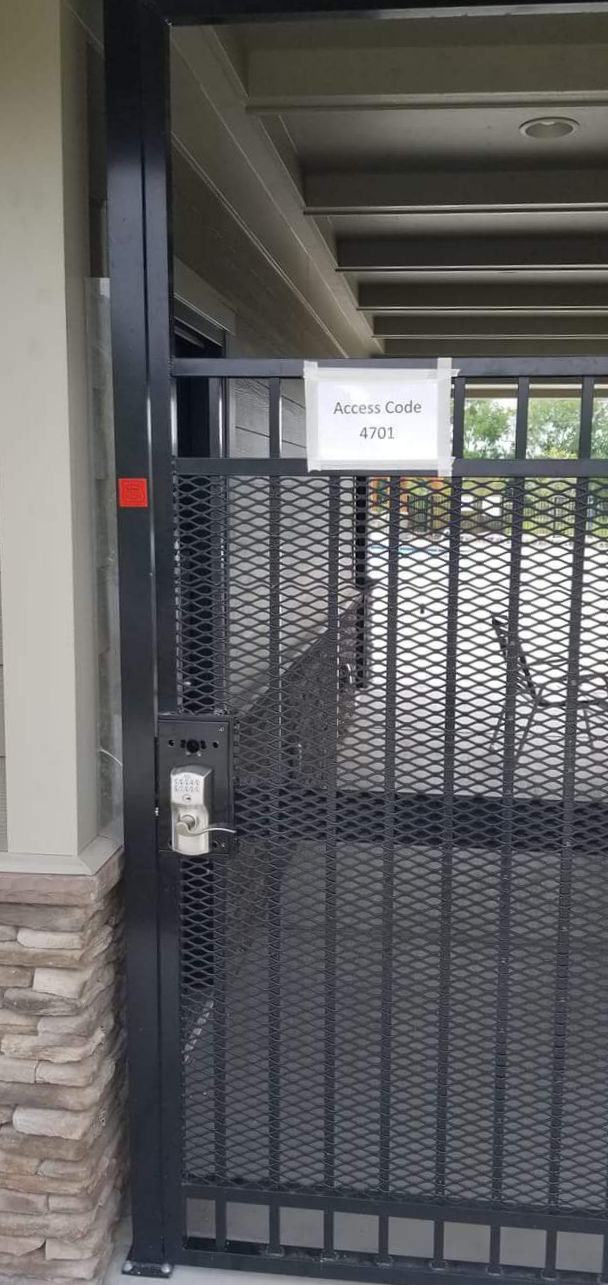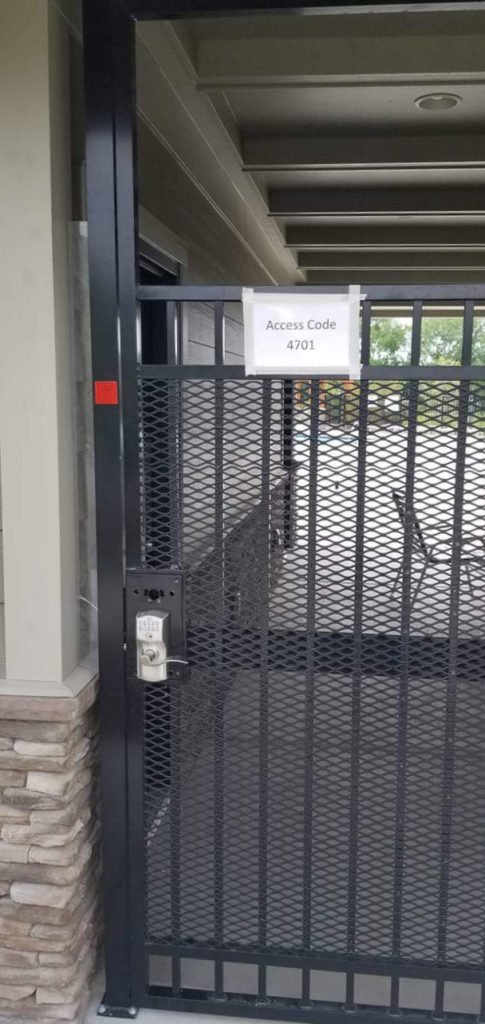Erin Banks of Allegion sent me this photo of a keypad lock on a swimming pool entrance. On the surface, it’s a typical Fixed-it Friday photo depicting the struggle between convenience and security. But considering that it’s a swimming pool, and the hardware is mounted at “normal” height – not 54 inches above the walking surface, there’s more ponder (read on).
The codes and standards are not 100% clear on this the way they’re currently written, but the intent (as I understand it) is this. When a pool gate is self-locking and requires a key or access-control credential to enter, the hardware can be mounted at the “normal” height – between 34 and 48 inches above the floor or ground.
When a pool gate is not self-locking and locked at all times, the access-side hardware has to be mounted at 54 inches above the floor or ground to prevent young children from entering the pool unaccompanied.
In this case, the gate requires a code to enter so the hardware can be mounted at normal height. But the code is posted on the gate. Is this acceptable because young children can’t read or interpret the meaning of the sign?
I’m curious about what age children are prevented access by the 54-inch mounting height, and whether that jives with the age of children are too young to read the sign and enter the code.
Thoughts?
You need to login or register to bookmark/favorite this content.







I wonder if it is geared more to average height / age???
https://www.babycenter.com/0_your-childs-size-and-growth-timeline_10357633.bc
My interpretation of the language of this exception is that hardware can be mounted up to 54″ unless it is also self-locking, not that it has to be mounted at 54″ if it isn’t self-locking (i.e., the 54″ allowance is “permitted”, but not “required” for non-self-locking hardware)?
Hi Joe –
The code is not very clear on this, but the intent is for the access-side hardware to be mounted at 54 inches AFF if the gate is not self-closing, self-latching, and self-locking. If you look at the section below from the 2015 IBC, it sort of says that near the end:
3109.4.1.7 Gates. Access doors or gates shall comply with the requirements of Sections 3109.4.1.1 through 3109.4.1.6 and shall be equipped to accommodate a locking device. Pedestrian access doors or gates shall open outward away from the pool and shall be self-closing and have a self-latching device. Doors or gates other than pedestrian access doors or gates shall have a self-latching device. Release mechanisms shall be in accordance with Sections 1010.1.9 and 1109.13. Where the release mechanism of the self-latching device is located less than 54 inches (1372 mm) from the bottom of the door or gate, the release mechanism shall be located on the pool side of the door or gate 3 inches (76 mm) or more, below the top of the door or gate, and the door or gate and barrier shall be without openings greater than 1/2 inch (12.7 mm) within 18 inches (457 mm) of the release mechanism.
This allows a release mechanism lower than 54 inches, but only on the pool side of the gate.
– Lori
Irregardless of the height of the lock, my opinion (And, I would think the opinion of any lawyer worth his salt) is that by posting the access code on the gate the installed hardware turns from a Lock to a Passage set rendering the owners liable to an expensive lawsuit following an unfortunate accident. I would think it would render their insurance null and void as well.
I would agree with you that placing the code on the door removes all considerations that this is a locked gate and is accessible to all.
My oldest is fairly average height for her age. She couldn’t really understand numbers (nor did she pay attention to them) until a time where she could fairly easily reach 54″ inches…She was somewhere close to 5 if I had to guess. However, even if she could read it at 4, a 4 year old typically knows not to go in until the parent says it’s acceptable. All that said, let’s talk about the other liability risks involved with posting the code… like unauthorized use and access. If someone who is not supposed to have access goes in and makes a total wreck of the place or injures themselves, that’s a liability issue.
Liability wise, I’m wondering if this is a pool in an apartment or condo complex and a tenant temporarily posted their access code for a pool party or something. It looks like it was just put there and very temporary. If so, management probably didn’t let it stay there.
I have a feeling that if someone really wanted in and didn’t have the code they’d climb over the gate.
Per 3109 4.1.7, IMO, this entire latching / locking arrangement does not comply. Simply stated, the release mechanism is not mounted at or above 54″. Providing the access code negates the locking, so at best this is a self-latching mechanism. This residential lock set has a turn knob on the back side that can anyone can leave the locking mechanism unlatched so the security of the entire device is questionable. (FWIW -from video game, smart phone, computers, etc. it is amazing how many 3 year olds can understand technology and easily enter numeric passwords. Schlage and other brands have sold residential keypad lock sets for years which are now installed on tens of thousands of homes, many with small children. It is reasonable to expect that in the majority of these homes even young children are taught how to use the passcode so they do not get locked out.)
Also worth noting: While the small mesh size of the screen on the gate does prevent a toe hold, the rough face of the lower rock wall does not. A really determined child could easily climb to the top of the rock wall and then get over this gate and into the pool area. So even a child, using just their own mind or body could bypass this gate with relative ease. For anyone with a young child who is a “climber” it is amazing how resourceful and ingenious they can be, even at 2 and 3 years of age, when they want to get into, over, on top of something… including using pretty much any available object to assist them… something many of the code requirements fail to appreciate and take into consideration as currently written.